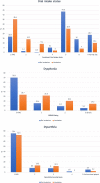Dysphagia, Dysphonia, and Dysarthria Outcomes Among Adults Hospitalized With COVID-19 Across Ireland
- PMID: 34622966
- PMCID: PMC8662217
- DOI: 10.1002/lary.29900
Dysphagia, Dysphonia, and Dysarthria Outcomes Among Adults Hospitalized With COVID-19 Across Ireland
Abstract
Objective: To investigate the presence, degree, predictors, and trajectory of dysphagia, dysphonia, and dysarthria among adults hospitalized with COVID-19 across the Republic of Ireland (ROI) during the first wave of the pandemic.
Study design: Prospective observational cohort study.
Methods: Adults with confirmed COVID-19 who were admitted into 14 participating acute hospitals across ROI and referred to speech and language therapy between March 1st and June 30th, 2020 were recruited. Outcomes obtained at initial SLT evaluation and at discharge were oral intake status (Functional Oral Intake Scale), perceptual voice quality (GRBAS), and global dysarthria rating (Dysarthria Severity Scale).
Results: Data from 315 adults were analyzed. At initial SLT assessment, 84% required modified oral diets, and 31% required tube feeding. There were high rates of dysphonia (42%) and dysarthria (23%). History of intubation (OR 19.959, 95% CI 6.272, 63.513; P = .000), COVID-19 neurological manifestations (OR 3.592, 95% CI 1.733, 7.445; P = .001), and age (OR 1.034; 95% CI 1.002, 1.066; P = .036) were predictive of oral intake status. History of intubation was predictive of voice quality (OR 4.250, 95% CI 1.838, 9.827; P = .001) and COVID-19 neurological manifestations were predictive of dysarthria (OR 2.275; 95% CI 1.162, 4.456; P = .017). At discharge, there were significant improvements in oral intake (Z = -7.971; P = .000), voice quality (Z = -5.971; P = .000), and dysarthria severity (Z = -2.619; P = .009), although need for modified oral intake (59%), dysphonia (23%), and dysarthria (14%) persisted.
Conclusion: Dysphagia, dysphonia, and dysarthria were widespread among adults hospitalized with COVID-19 and they persisted for many at discharge. Prompt SLT evaluation is required to minimize complications.
Level of evidence: 3 Laryngoscope, 132:1251-1259, 2022.
Keywords: COVID-19; SARS-CoV-2; communication; dysarthria; dysphagia; dysphonia; sequelae; swallowing; voice.
© 2021 The Authors. The Laryngoscope published by Wiley Periodicals LLC on behalf of The American Laryngological, Rhinological and Otological Society, Inc.
Figures




References
-
- Marini JJ, Gattinoni L. Management of COVID‐19 respiratory distress. JAMA 2020;323:2329–2330. - PubMed
Publication types
MeSH terms
LinkOut - more resources
Full Text Sources
Medical
Research Materials
Miscellaneous

